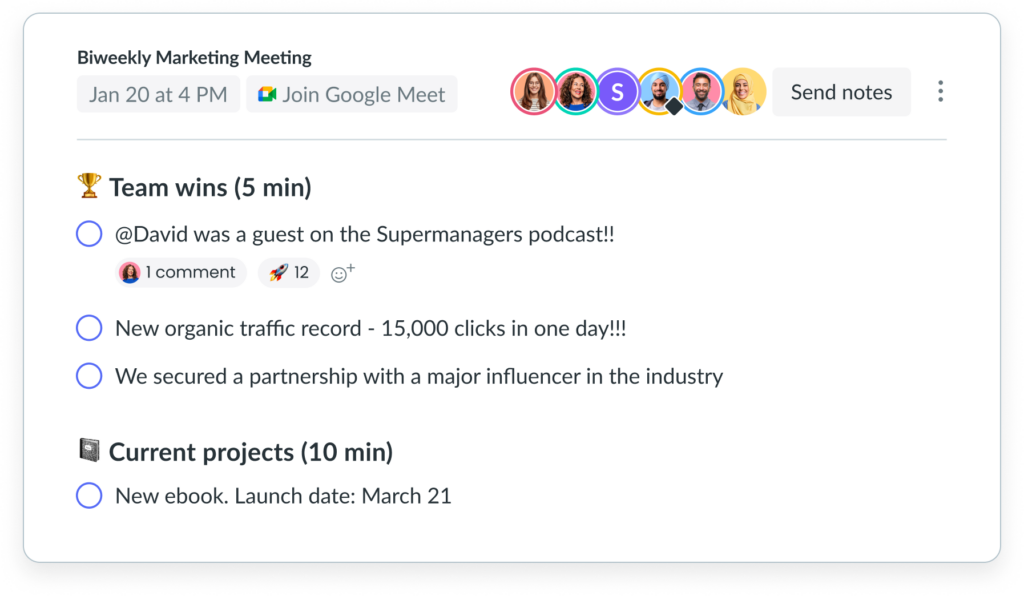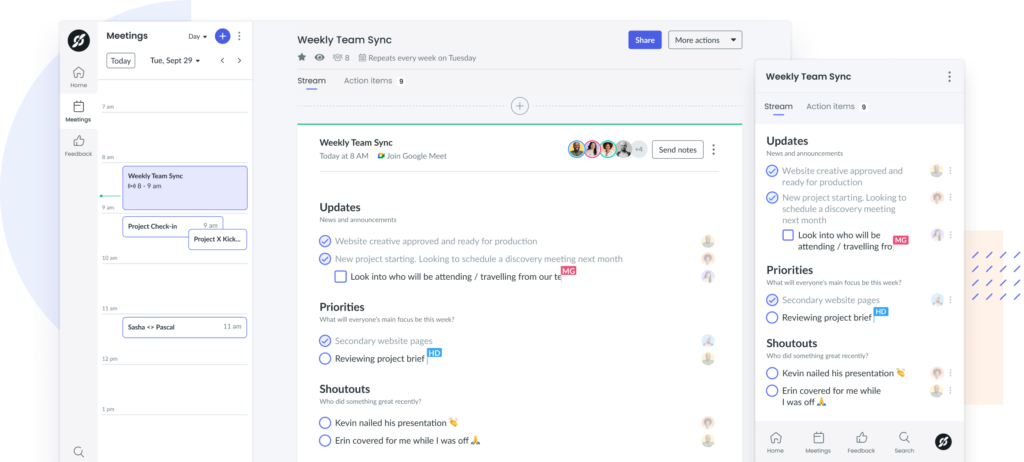Improve Workplace Productivity: 13 Proven Strategies
Learn how to grow your business with these 13 powerful tips to improve workplace productivity! Plus, see how Fellow can help.
Time and time again, managers run into the challenge of feeling like they’ve got a great set of talent on their team, but they’re just not sure how to truly maximize these in-house skills. If this sounds like you, taking time to evaluate your team’s current dynamics and optimizing your workflow can help you improve workplace productivity—possibly even across the teams you work alongside, too. To help get you started, we’re sharing 13 of our best strategies below!
13 ways to improve workplace productivity
- Improve communication skills
- Focus on high-priority tasks
- Set clear OKRs
- Adopt productivity software
- Encourage learning opportunities
- Follow a morning routine
- Run productive meetings
- Delegate tasks
- Create a culture of regular feedback
- Avoid multitasking
- Take breaks
- Limit distractions
- Use the time-blocking method
1Improve communication skills
Both verbal and non-verbal communication skills are important in the workplace. Verbal communication skills should focus on having language that is constructive, concise, clear, and supportive (especially during times of conflict). Non-verbal forms of communication include minding body language like facial expressions, eye contact, and positioning of your body. It’s even harder to practice great communication skills over remote working platforms like Zoom; to overcome this, try to keep your camera on and leverage non-verbal tools like comment boxes and reaction buttons.
2Focus on high-priority tasks
When there are a lot of activities going on at once, it’s helpful to narrow down which tasks are high priority. Urgency can be driven by several factors, such as how close the deadline is, the authoritative weight of the stakeholder driving the request, or the revenue value attached to the completion of the task. When generating a project brief, collecting information about urgency will help you properly evaluate how to prioritize effectively.

Run efficient meetings, come to a decision, and get back to work
Level up your meeting habits to boost engagement and productivity with a collaborative meeting agenda. Try a tool like Fellow!

3Set clear OKRs
Objectives and key results (OKRs) are a way of setting goals in organizations. Corporate leaders, team managers, and individual employees can all set their own OKRs, but they must all align with the same bigger goal o be effective. Tracking progress on your OKRs as part of every meeting will remind your team about the end goal with which they need to align all activities. Doing this tracking also allows managers to view progress on goal attainment over time, and this makes it easy to see if more support resources are required to see successful OKRs.
With Fellow, you can stay on top of your team’s goals by clearly recording, defining, and tracking the progress of your OKRs in Fellow’s Objectives tool.

4Adopt productivity software
Productivity software can save a lot of time for you and your team. You can leverage productivity tools to automate functions like note-taking, calendar event scheduling, tracking to-do lists, or setting reminders for upcoming events. This minimizes context switching on small, mundane, or administrative tasks.
Fellow is an example of productivity software. It helps teams stay efficient by allowing them to create collaborative meeting agendas and notes. With multiple integrations and a Chrome extension, it also makes your shared notes space available directly within your call, so you’ll spend less time flipping between tabs and more time talking about business growth.

5Encourage learning opportunities
A growth mindset is a good feature to look for in any new hire, and it can also be developed for any existing team member. To fuel this mindset, you’ll need to provide consistent learning opportunities. Some employees may benefit from a formal training program such as an online or in-person course, while others might prefer informal learning such as mentorship groups or the opportunity to take on more challenging projects. You can also incentivize upskilling by offering promotions to employees who are continuously taking on new learning opportunities!
6Follow a morning routine
Creating routines is proven to aid your overall health and wellness, as having routines reduces stress and makes your day slightly more predictable. It can also allow you to become more efficient with microtasks within your routine, which feel like “quick wins” at the start of each day. It’s up to you to decide exactly what to do in your morning routine, but some ideas include:
- Reading the news
- Meditating
- Journaling
- Doing a stretch or yoga
- Going for a run
- Making healthy juice
- Taking a cold shower
7Run productive meetings
Productive meetings are all about having a purpose and then organizing the discussion of the topics within that meeting’s purpose. Fellow’s entire mission is to make this process easier for teams, and some ways that we recommend doing this include:
- Building and sharing a collaborative meeting agenda at least one day ahead of the call
- Only inviting necessary participants so you don’t have too many conversations ongoing at one time (and offer a post-call recording to anyone who can’t make it)
- Attaching relevant documentation, goals, plans, and recordings to the meeting notes for reference during the meeting and after the call
- Taking shared notes throughout the meeting to ensure alignment
- Identifying and assigning action items in the meeting and setting due dates for completion where possible
- Requesting feedback in a post-meeting survey to see where the meeting can improve next time

8Delegate tasks
One of the main causes of burnout is when team members take on too much. This is even more true for managers and project leaders who have started an initiative and feel ownership over it, so they’re hesitant to delegate the work to anyone else. Unfortunately, maintaining ownership isn’t always ideal for making the best use of everyone’s time and skills. Instead, delegating tasks can improve trust between team members, allow for the correct distribution of skills to project tasks, allow those with more time to take on new projects, and even grant growth opportunities to more junior employees.
9Create a culture of regular feedback
Feedback cycles are incredibly important for any team. For new employees, getting constructive feedback helps them to optimize their performance in their first few months and improves the likelihood of retention within the team. For managers and older employees, feedback rounds help continuously identify areas of improvement. As a best practice, try asking for feedback on recent performance in every meeting you can!

10Avoid multitasking
Even though it sounds super productive to do many things at once, it actually isn’t all that great for your efficiency! When you’re multitasking, you’re actually requiring your brain to context switch between many things at once. Over the long term, this tires you out and leads to burnout.
Instead, focus on one task at a time. If you have a large task at hand, consider breaking it up into a checklist of “to-do” items so it becomes actionable and digestible. You’ll put much more care and quality into your work this way!
11Take breaks
According to an article by Forbes,
“Sitting at a desk all day is unhealthy and can lower your employees’ motivation and energy. Your team should be encouraged to stand up and stretch or exercise during their breaks.”
One tactical approach to integrate breaks into your workday is the Pomodoro Technique, which is especially helpful for anyone who needs a plan for their day. With the Pomodoro Technique, you have 25-minute intervals of deep focus time on a specific action item, and then 5 minutes of break. This 30-minute cycle is a “Pomodoro,” and for every four that you do, you should take a longer break.
12Limit distractions
Phones, clutter, and ringing doorbells all make work a bit more distracting. Whether you’re working in a remote or in-person environment, consider putting yourself in a room that doesn’t have access to a lot of distractions. It’s helpful to communicate your focus time to your coworkers either by setting a status on your communication platform (for example, Slack or Microsoft Teams), or putting a good-old sticky note on the door!
If you can’t find a dedicated focus space in which you can work, consider using noise-canceling headphones or try scheduling distractions (like phone calls or at-home deliveries) to happen around the same time.
13Use the time-blocking method
The time-blocking method is a calendar management approach to help you maximize your work day. How it works is that you block off segments of your calendar—usually in sections of 1 to 4 hours in length—for designated activities. For example, you might choose to set the first hour of every morning for catching up on emails and industry news. It’s a great way to communicate availability to your teams, and it gives you dedicated time to crunch out high-priority tasks. A good habit is to treat your time blocks as sacred and avoid moving them around for other meetings and impromptu conversations unless absolutely necessary.
Parting advice
Fortunately for any leader, there are limitless ways to improve your workplace productivity! Doing so can reap great benefits like higher revenue, better team retention, improved team morale, and even better experiences for your end users! The great thing about this process is that it’s constantly evolving and allows you to get creative to find what works for your team. Consider getting some of your industry peers involved to see what’s worked for them and try it for your team too. And let us know if something great worked—we’re always excited to hear how you’re making the day-to-day more efficient!











